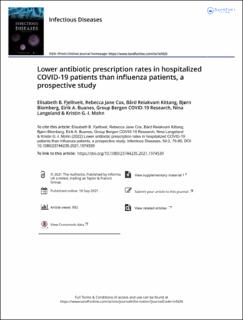| dc.contributor.author | Fjelltveit, Elisabeth Berg | |
| dc.contributor.author | Cox, Rebecca Jane | |
| dc.contributor.author | Kittang, Bård Reiakvam | |
| dc.contributor.author | Blomberg, Bjørn | |
| dc.contributor.author | Buanes, Eirik A. | |
| dc.contributor.author | Langeland, Nina | |
| dc.contributor.author | Mohn, Kristin Greve-Isdahl | |
| dc.date.accessioned | 2022-04-20T09:53:36Z | |
| dc.date.available | 2022-04-20T09:53:36Z | |
| dc.date.created | 2021-10-04T20:42:15Z | |
| dc.date.issued | 2022 | |
| dc.identifier.issn | 2374-4235 | |
| dc.identifier.uri | https://hdl.handle.net/11250/2991566 | |
| dc.description.abstract | Background
COVID-19 patients are extensively treated with antibiotics despite few bacterial complications. We aimed to study antibiotic use in hospitalized COVID-19 patients compared to influenza patients in two consecutive years. Furthermore, we investigated changes in antibiotic use from the first to second pandemic wave.
Methods
This prospective study included both patients from two referral hospitals in Bergen, Norway, admitted with influenza (n = 215) during the 2018/2019 epidemic and with COVID-19 (n = 82) during spring/summer 2020, and national data on registered Norwegian COVID-19 hospital admissions from March 2020 to January 2021 (n = 2300). Patient characteristics were compared, and logistic regression analysis was used to identify risk factors for antibiotic use.
Results
National and local COVID-19 patients received significantly less antibiotics (53% and 49%) than influenza patients (69%, p < .001). Early antibiotics contributed to >90% of antibiotic prescriptions in the two local hospitals, and >70% of prescriptions nationally. When adjusted for age, comorbidities, symptom duration, chest X-ray infiltrates and oxygen treatment, local COVID-19 patients still had significantly lower odds of antibiotic prescription than influenza patients (aOR 0.21, 95%CI 0.09–0.50). At the national level, we observed a significant reduction in antibiotic prescription rates in the second pandemic wave compared to the first (aOR 0.35, 95% CI 0.29–0.43).
Conclusion
Fewer COVID-19 patients received antibiotics compared to influenza patients admitted to the two local hospitals one year earlier. The antibiotic prescription rate was lower during the second pandemic wave, possibly due to increased clinical experience and published evidence refuting the efficacy of antibiotics in treating COVID-19 pneumonia. | en_US |
| dc.language.iso | eng | en_US |
| dc.publisher | Taylor & Francis | en_US |
| dc.rights | Attribution-NonCommercial-NoDerivatives 4.0 Internasjonal | * |
| dc.rights.uri | http://creativecommons.org/licenses/by-nc-nd/4.0/deed.no | * |
| dc.title | Lower antibiotic prescription rates in hospitalized COVID-19 patients than influenza patients, a prospective study | en_US |
| dc.type | Journal article | en_US |
| dc.type | Peer reviewed | en_US |
| dc.description.version | publishedVersion | en_US |
| dc.rights.holder | Copyright 2021 The Author(s) | en_US |
| cristin.ispublished | true | |
| cristin.fulltext | original | |
| cristin.qualitycode | 1 | |
| dc.identifier.doi | 10.1080/23744235.2021.1974539 | |
| dc.identifier.cristin | 1943199 | |
| dc.source.journal | Infectious Diseases | en_US |
| dc.source.pagenumber | 79-89 | en_US |
| dc.identifier.citation | Infectious Diseases. 2022, 54 (2), 79-89. | en_US |
| dc.source.volume | 54 | en_US |
| dc.source.issue | 2 | en_US |

